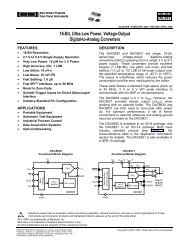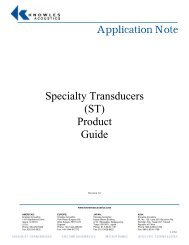AD7714* 3 V/5 V, CMOS, 500 µA Signal Conditioning ADC - dreamm
AD7714* 3 V/5 V, CMOS, 500 µA Signal Conditioning ADC - dreamm
AD7714* 3 V/5 V, CMOS, 500 µA Signal Conditioning ADC - dreamm
You also want an ePaper? Increase the reach of your titles
YUMPU automatically turns print PDFs into web optimized ePapers that Google loves.
AD7714<br />
Pin<br />
No. Mnemonic Function<br />
PIN FUNCTION DESCRIPTION (Continued)<br />
19 CS Chip Select. Active low Logic Input used to select the AD7714. With this input hard-wired low, the AD7714<br />
can operate in its three-wire interface mode with SCLK, DIN and DOUT used to interface to the device. CS<br />
can be used to select the device in systems with more than one device on the serial bus or as a frame<br />
synchronization signal in communicating with the AD7714.<br />
20 DRDY Logic output. A logic low on this output indicates that a new output word is available from the AD7714 data<br />
register. The DRDY pin will return high upon completion of a read operation of a full output word. If no data<br />
read has taken place, after an output update, the DRDY line will return high for <strong>500</strong> × t CLK IN cycles prior to<br />
the next output update. This gives an indication of when a read operation should not be attempted to avoid<br />
reading from the data register as it is being updated. DRDY is also used to indicate when the AD7714 has<br />
completed its on-chip calibration sequence.<br />
21 DOUT Serial Data Output with serial data being read from the output shift register on the part. This output shift<br />
register can contain information from the calibration registers, mode register, communications register, filter<br />
selection registers or data register depending on the register selection bits of the Communications Register.<br />
22 DIN Serial Data Input with serial data being written to the input shift register on the part. Data from this input shift<br />
register is transferred to the calibration registers, mode register, communications register or filter selection<br />
registers depending on the register selection bits of the Communications Register.<br />
23 DV DD Digital Supply Voltage, +3.3 V or +5 V nominal.<br />
24 DGND Ground reference point for digital circuitry.<br />
TERMINOLOGY*<br />
INTEGRAL NONLINEARITY<br />
This is the maximum deviation of any code from a straight line<br />
passing through the endpoints of the transfer function. The endpoints<br />
of the transfer function are zero scale (not to be confused<br />
with bipolar zero), a point 0.5 LSB below the first code transition<br />
(000 . . . 000 to 000 . . . 001) and full scale, a point<br />
0.5 LSB above the last code transition (111 . . . 110 to<br />
111 . . . 111). The error is expressed as a percentage of full<br />
scale.<br />
POSITIVE FULL-SCALE ERROR<br />
Positive Full-Scale Error is the deviation of the last code transition<br />
(111 . . . 110 to 111 . . . 111) from the ideal AIN(+) voltage<br />
(AIN(–) + V REF /GAIN – 3/2 LSBs). It applies to both unipolar<br />
and bipolar analog input ranges.<br />
UNIPOLAR OFFSET ERROR<br />
Unipolar Offset Error is the deviation of the first code transition<br />
from the ideal AIN(+) voltage (AIN(–) + 0.5 LSB) when operating<br />
in the unipolar mode.<br />
BIPOLAR ZERO ERROR<br />
This is the deviation of the midscale transition (0111 . . . 111<br />
to 1000 . . . 000) from the ideal AIN(+) voltage (AIN(–) –<br />
0.5 LSB) when operating in the bipolar mode.<br />
GAIN ERROR<br />
This is a measure of the span error of the <strong>ADC</strong>. It includes fullscale<br />
errors but not zero-scale errors. For unipolar input ranges<br />
it is defined as (full-scale error – unipolar offset error) while for<br />
bipolar input ranges it is defined as (full-scale error – bipolar<br />
zero error).<br />
BIPOLAR NEGATIVE FULL-SCALE ERROR<br />
This is the deviation of the first code transition from the ideal<br />
AIN(+) voltage (AIN(–) – V REF /GAIN + 0.5 LSB) when operating<br />
in the bipolar mode.<br />
POSITIVE FULL-SCALE OVERRANGE<br />
Positive Full-Scale Overrange is the amount of overhead available<br />
to handle input voltages on AIN(+) input greater than<br />
AIN(–) + V REF /GAIN (for example, noise peaks or excess voltages<br />
due to system gain errors in system calibration routines)<br />
without introducing errors due to overloading the analog modulator<br />
or overflowing the digital filter.<br />
NEGATIVE FULL-SCALE OVERRANGE<br />
This is the amount of overhead available to handle voltages on<br />
AIN(+) below AIN(–) – V REF /GAIN without overloading the<br />
analog modulator or overflowing the digital filter. Note that the<br />
analog input will accept negative voltage peaks even in the unipolar<br />
mode provided that AIN(+) is greater than AIN(–) and<br />
greater than AGND – 30 mV.<br />
OFFSET CALIBRATION RANGE<br />
In the system calibration modes, the AD7714 calibrates its offset<br />
with respect to the analog input. The Offset Calibration<br />
Range specification defines the range of voltages that the<br />
AD7714 can accept and still calibrate offset accurately.<br />
FULL-SCALE CALIBRATION RANGE<br />
This is the range of voltages that the AD7714 can accept in the<br />
system calibration mode and still calibrate full scale correctly.<br />
INPUT SPAN<br />
In system calibration schemes, two voltages applied in sequence<br />
to the AD7714’s analog input define the analog input range.<br />
The input span specification defines the minimum and maximum<br />
input voltages from zero to full scale that the AD7714 can<br />
accept and still calibrate gain accurately.<br />
*AIN(–) refers to the negative input of the differential input pairs or to AIN6<br />
when referring to the pseudo-differential input configurations.<br />
–8–<br />
REV. B















